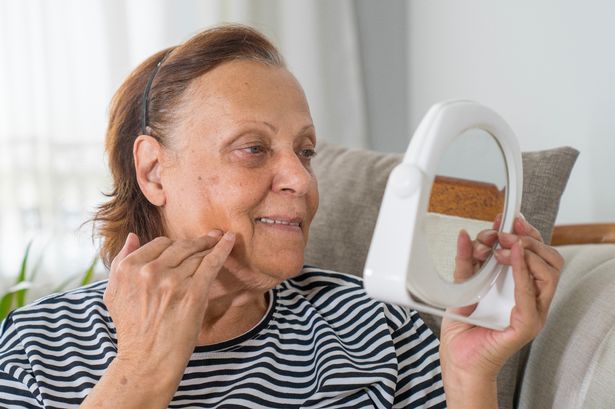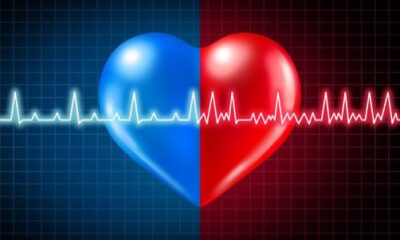Health
Watch for These Signs of High Cholesterol: Health Risks Revealed

High cholesterol often goes unnoticed, leading to serious health risks. It can quietly accumulate in the bloodstream, posing a significant threat to cardiovascular health. The British Heart Foundation (BHF) emphasizes the importance of monitoring cholesterol levels, noting that “there are usually no symptoms of high cholesterol.” This condition can cause blockages in arteries over time, increasing the likelihood of heart attacks or strokes.
Despite its often asymptomatic nature, there are visible signs of high cholesterol that may manifest in three key areas of the body: the face, hands, and legs. Recognizing these signals could prompt individuals to seek medical advice before serious complications arise.
Facial Indicators of High Cholesterol
One of the most noticeable signs of high cholesterol can appear on the face. Two specific conditions, known as xanthelasmas, can emerge as small, yellowish lumps located at the inner corners of the eyes. While these lumps are benign, their presence may indicate an increased risk of cardiac issues, such as diabetes and hypertension.
Additionally, individuals with high cholesterol may develop a corneal arcus, which is characterized by a pale white ring around the iris. The BHF advises that anyone noticing these changes should consult a healthcare professional for further evaluation.
Hand Symptoms to Monitor
In some cases, high cholesterol may also lead to the formation of bumps on the hands, specifically known as tendon xanthomata. These smooth, firm nodules typically appear over the knuckles or on the Achilles tendon, blending with the skin’s natural tone. According to dermatology specialists at Derm Net, these nodules are associated with familial hypercholesterolaemia, a genetic condition leading to elevated cholesterol levels.
It is crucial for individuals who notice these growths to seek medical guidance. Though they are not harmful themselves, they can be indicators of underlying health issues linked to cholesterol.
Leg Symptoms and Peripheral Arterial Disease
Elevated cholesterol levels can also contribute to a condition known as peripheral arterial disease (PAD). This widespread ailment occurs when fatty deposits restrict blood flow to the leg muscles. The NHS outlines several symptoms associated with PAD, including:
– Painful leg ache, particularly during physical activity
– Hair loss on the legs
– Numbness or weakness in the legs
– Non-healing ulcers on the legs
– Changes in skin color, such as paleness or a bluish tint
These symptoms may develop gradually, but if they appear suddenly or worsen significantly, immediate medical attention is recommended. The most common sign of PAD is a painful ache that typically subsides with rest.
To determine cholesterol levels accurately, individuals must undergo testing. The NHS advises lifestyle changes to manage high cholesterol, including adopting a balanced diet, increasing physical activity, quitting smoking, and reducing alcohol consumption.
Being aware of these visible signs is essential for proactive health management. Regular check-ups and screenings can help individuals stay informed about their cholesterol levels and overall cardiovascular health.
-

 Technology5 months ago
Technology5 months agoDiscover the Top 10 Calorie Counting Apps of 2025
-

 Health3 months ago
Health3 months agoBella Hadid Shares Health Update After Treatment for Lyme Disease
-

 Health3 months ago
Health3 months agoErin Bates Shares Recovery Update Following Sepsis Complications
-

 Technology4 months ago
Technology4 months agoDiscover How to Reverse Image Search Using ChatGPT Effortlessly
-

 Technology1 month ago
Technology1 month agoDiscover 2025’s Top GPUs for Exceptional 4K Gaming Performance
-

 Technology3 months ago
Technology3 months agoElectric Moto Influencer Surronster Arrested in Tijuana
-

 Technology5 months ago
Technology5 months agoMeta Initiates $60B AI Data Center Expansion, Starting in Ohio
-

 Technology5 months ago
Technology5 months agoRecovering a Suspended TikTok Account: A Step-by-Step Guide
-

 Health4 months ago
Health4 months agoTested: Rab Firewall Mountain Jacket Survives Harsh Conditions
-

 Lifestyle5 months ago
Lifestyle5 months agoBelton Family Reunites After Daughter Survives Hill Country Floods
-

 Technology4 months ago
Technology4 months agoHarmonic Launches AI Chatbot App to Transform Mathematical Reasoning
-

 Health3 months ago
Health3 months agoAnalysts Project Stronger Growth for Apple’s iPhone 17 Lineup













